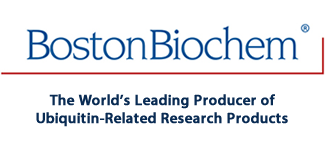
Human ISG15/UCRP Antibody Summary
Applications
Please Note: Optimal dilutions should be determined by each laboratory for each application.General Protocolsare available in the Technical Information section on our website.
Data Example
 View Larger
View LargerImmunoprecipitation of Human ISG15/UCRP.A549 cells transfected with HA-ISG15 were treated briefly with IFN gammaor carrier only. 500 µg of cell lysates were subjected to immunoprecipitation (IP) with 20 µg A-830 using Protein G Sepharose. IP’d material was resolved on reducing SDS-PAGE gels and Western Blots were developed using PVDF membranes and anti-HA epitope (R&D Systems MAB060) at 0.5 µg/ml followed by HRP-labeled anti-mouse (R&D Systems # HAF007) secondary antibody at 1:2000 dilution. Free (unconjugated) HA-ISG15 was visualized in both treated and untreated cells, while ISGylated proteins were clearly recovered (IP’d) from the interferon-treated cell lysates.
Reconstitution Calculator
Preparation and Storage
- 12 months from date of receipt, -20 to -70 °C, as supplied.
- 1 month, 2 to 8 °C under sterile conditions after opening.
- 6 months, -20 to -70 °C under sterile conditions after opening.
Background: ISG15/UCRP
Interferonstimulated Gene 15 (ISG15), also known as Ubiquitin Crossreacting Protein (UCRP), is a Ubiquitinlike protein that is covalently coupled to target proteins in a process termed ISGylation. It is a 165 amino acid (aa) polypeptide with a predicted molecular weight of 18 kDa. ISG15/UCRP exhibits 66% aa sequence identity with its mouse ortholog. Structurally, ISG15/UCRP consists of two tandem Ubiquitinlike domains that share a similar 3dimensional structure with Ubiquitin and other Ubiquitinlike modifiers including NEDD8 and SUMO1. Modification of targets by ISG15/UCRP occurs in a stepwise enzymatic process similar to that of Ubiquitin. Enzymes regulating ISGylation include the activating (E1) enzyme UBE1L, the conjugating (E2) enzyme UbcH8, and ligases (E3) such as HERC5. Removal of ISG15/UCRP is catalyzed by the deconjugating enzyme UBP43/USP18. Functionally, ISG15/UCRP has putative roles in the immune response and tumorigenesis. This is reflected by intracellular ISG15/UCRP targets that include Cyclin D1, tumor suppressor p63, IRF3, and a range of viral proteins. It is induced by type 1 interferons and microbial infection, and knockout mice exhibit an increased sensitivity to infection by some viruses. ISG15/UCRP can also be secreted by cells of the immune system and may act in a cytokinelike manner. For instance, it is produced by human granulocytes in response to mycobacterium exposure, and natural killer cells and T cells respond to extracellular ISG15/UCRP with IFNgamma production. Further supporting a role in immune function, ISG15/UCRP mutations are associated with MSMD, an inherited disorder characterized by increased susceptibility to mycobacterial infection.
Product Datasheets
Citation for Human ISG15/UCRP Antibody
R&D Systems personnel manually curate a database that contains references using R&D Systems products.The data collected includes not only links to publications in PubMed,but also provides information about sample types, species, and experimental conditions.
1Citation: Showing 1 - 1
- Covalent ISG15 conjugation to CHIP promotes its ubiquitin E3 ligase activity and inhibits lung cancer cell growth in response to type I interferonAuthors: L Yoo, AR Yoon, CO Yun, KC ChungCell Death Dis, 2018;9(2):97.Species: HumanSample Types: Cell LysatesApplications: Western Blot
FAQs
No product specific FAQs exist for this product, however you may
View all Antibody FAQsExactaChIP Chromatin Immunoprecipitation Kits
ExactaChIP Chromatin IP Buffer Panel
Isotype Controls
Normal Rat IgG Control(Azide Free)
Normal Rat IgG Control
Rat IgG2A Isotype Control
Rat IgG2A Isotype Control
Secondary Antibodies
Rat IgG HRP-conjugated Antibody
Goat Anti-Rat F(ab)2 IgG (H+L) APC-conjugated Antibody
Rat F(ab)2 IgG (H+L) Fluorescein-conjugated Antibody
Goat Anti-Rat IgG NorthernLights™ NL637-conjugated Antibody
Goat Anti-Rat IgG NorthernLights™ NL557-conjugated Antibody
Goat Anti-Rat IgG NorthernLights™ NL493-conjugated Antibody
Goat Anti-Rat IgG Antibody
Rat F(ab)2 IgG (H+L) PE-conjugated Antibody
Rat IgG VisUCyte HRP Polymer Antibody
Goat Anti-Rat IgG Biotinylated Antibody
Goat Anti-Rat F(ab)2 IgG (H+L) PerCP-conjugated Antibody
Reviews for Human ISG15/UCRP Antibody
There are currently no reviews for this product. Be the first toreview Human ISG15/UCRP Antibody and earn rewards!
Have you used Human ISG15/UCRP Antibody?
Submit a review and receive an Amazon gift card.
$25/€18/£15/$25CAN/¥75 Yuan/¥1250 Yen for a review with an image
$10/€7/£6/$10 CAD/¥70 Yuan/¥1110 Yen for a review without an image
ebiomall.com






>
>
>
>
>
>
>
>
>
>
>
>
如果女方的该基因为双显,则后代不会换此病(基因突变除外,所有基因都可能突变,但概率何其小);如果女方为单显,则男孩有一半的概率致病,女孩不会致病;如果女方也为隐性,则男孩致病,那就要个女孩吧。
结论,能不能生育去医院做精液检查就清楚了,如果可育,再让女方做个DNA鉴定以决定生儿育女。
酶只是催化剂,其本身无法直接氧化它。
酶是具有生物催化功能的生物大分子,即生物催化剂,它能够加快生化反应的速度,但是不改变反应的方向和产物。其只能用于改变各类生化反应的速度,但并不是生化反应本身。只是催化剂的一种。
所以NADPH氧化酶只是促进了NADPH的氧化过程,无法直接氧化NADPH。
求助,做蛋白酶抑制试验,胃蛋白酶抑制剂不溶于水,需要先溶于甲醇再加入酶液里面吗,还是直接加入酶液里面就可以起作用呢,求大神指点啊
Nutrition.2005Jul-Aug;21(7-8):838-47.
OBJECTIVE:Involvementoflipoxygenase(LOX)andcyclo-oxygenase(COX)oncellulardifferentiationorapoptosisinducedbybutyratehasbeenreportedrecently,buttheeffectontightjunction(TJ)permeabilityhasnotbeenreported.Onemajoractivityofbutyrateand,toalesserextent,propionateistomodulategenetranscriptionviahistoneacetylationbytheirhistonedeacetylaseinhibitoractivity.Inthisstudy,weevaluatedtheactivationofLOXandCOXinTJpermeabilitychangesbyshort-chainfattyacids,butyrate,propionate,andacetateinintestinalmonolayercellsandtheirpossIBLemechanismbyhistoneacetylation.METHODS:TheeffectsofLOXandCOXinhibitorsonTJpermeabilityandtheexpressionofLOXorCOXmRNAinducedbyshort-chainfattyacidswereinvestigatedinCaco-2cellsusingTranswellchambers.Theeffectsofhydroxyeicosatetraenoicacid(aproductofLOX)onTJpermeabilitywerealsoevaluated.Theeffectsofshort-chainfattyacidswerecomparedwiththoseoftrichostatinA(histonedeacetylaseinhibitor).RESULTS:ALOXinhibitorclearlyinhibitedtheeffectofbutyrateonTJpermeability,whereasCOXinhibitorsdidnot.TheLOXandCOXinhibitorspartlyinhibitedtheeffectsofpropionatebutnotofacetate.ButyrateincreasedLOXmRNAexpression,andhydroxyeicosatetraenoicacidandtrichostatinAmimickeditseffect.CONCLUSION:Theseresultssuggestthatshort-chainfattyacids,especiallybutyrate,induceTJpermeabilitychangesthroughLOXactivationthroughhistoneacetylation.
在肠腔,短链脂肪酸可以通过激活脂肪氧化酶的活性从而改变单层细胞间紧密连接的通透性
目的:最近,有文献报道了丁酸盐可以诱导细胞的分化或者凋亡,并且这种效应与脂肪氧化酶(LOX)以及环氧合酶(COX)有关,但是,关于丁酸盐对紧密连接的影响目前未见报道。人们已经知道,丁酸盐以及丙酸盐都可以通过他们对组蛋白去乙酰化酶的抑制作用从而引起组蛋白的乙酰化,并最终实现对基因转录的调控。在我们的研究中,我们研究了短链脂肪酸、丁酸盐、丙酸盐以及醋酸盐对肠上皮细胞间紧密连接通透性的影响,以及这种变化过程中LOX和COX的活化情况,并且研究了这些物质引起组蛋白乙酰化的可能机制。
方法:实验者利用Caco-2细胞以及Transwell小室建立肠腔的体外模型,研究了几种LOX、COX抑制物质对紧密连接通透性的影响,以及对LOX、COXmRNA水平的影响。同时,还研究了羟基二十碳四烯酸(这是一种LOX的催化产物)对TJ通透性的影响。在实验中,研究者还将几种短链脂肪酸的效应与曲古抑菌素A(一种组蛋白去乙酰化酶抑制剂)的效应进行了比较。
结果:使用LOX抑制剂能够明显的抑制丁酸盐所引起的紧密连接通透性的增加,而COX抑制剂则没有这种作用。丁酸盐能够增加细胞中LOXmRNA的表达水平,而羟基二十碳四烯酸以及曲古抑菌素A也都有类似的作用。
结论:以上结果表明,短链脂肪酸,尤其是丁酸盐,能够通过对组蛋白的乙酰化作用活化LOX,并且导致肠上皮细胞间紧密连接通透性的增加。
不加磷酸化抑制剂也可以做磷酸化蛋白WB,但是有可能会影响具体的实验结果,大部分时候不加磷酸化抑制剂也能得到结果的。
需要注意蛋白的磷酸化是一个非常迅速的反应,所以取样品的过程要迅速,样品要新鲜。
所以做磷酸化蛋白WB,提取蛋白时不加磷酸酶抑制剂会有影响









